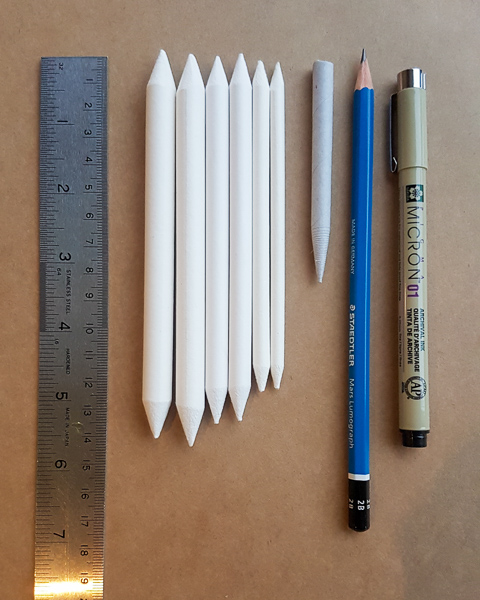Paper Stumps and Tortillons are delicious tools and both have their own merits, and I will sit on the fence as to which I recommend as I think it depends on the situation – so read on and work out which is better for you and your project!
Tortillon – a rolled up short paper blending tool with a hollow core.
Perfect if you are confident with your pressure, a great delicate fine tool, easy to load with graphite and move it into an exact spot, angle, curve or line when you use it flat to the paper. It’s French for “something twisted’ – and this is exactly what it is, a short piece of paper twisted up.
Be warned if you hold this like a traditional pencil you will end up drilling the point inside itself. Hence why they are short in length – so hold it tucked inside the palm of your hand as you use it, and that also makes it easier to see exactly where the point is going.
You can’t sharpen these, so if you find the point is disappearing, to bring it back to life (despite using it flat, you can’t use no pressure), you can use an unwound paperclip, and insert the length of metal down the middle hollow core and gently push the point back out, and therefore extend its life. But note, it is a ‘not very expensive small bit of paper’; it doesn’t last for lots of sustained use, mine last me a couple of months, although it does not survive the washing machine when left tucked in a pocket.
Paper stump – a robust, shortish pencil length blending tool with a solid core.
Perfect if you are not so confident with your pressure, or a beginner at shading, and a great tool for children as it’s more robust than a tortillon. It is much easier to hold traditionally like a pencil/pen. Various sizes available to cope with fine, medium or large scale work. These too, I am afraid do not survive the washing machine cycle…
Neither can you sharpen these in a pencil sharpener, but instead use a piece of sandpaper or an emery board to re shape/clean. I switch between using sandpaper at home and a metal nail file if I’m out and about. Once you have a point again, off you go. These do last longer than tortillons, as they are not as delicate a construction. Really suited to those not used to working with light pressure and they are perfect for bigger scale. If tangling on a tile make sure you have one of the smaller sizes.
Thin or Small size – better suited to small work and those who might otherwise use a tortillon, but who like a solid feel when shading, or are not so confident at the start.
Medium size – I usually recommend this for kids, as this is a robust item, and can work with various pressures from different abilities and ages. They can hold it like a traditional pencil/ pen. The medium size is great for working slightly larger than a traditional tile, and ideal for shading large areas. On a bigger piece I might switch between a medium size and then a smaller tool (both tortillon and stump) for finer areas.
Large – if your mantra is go big or go home, then this is the tool for you, it’s large so you can cope with expansive areas and larger scales – I used this when I did a piece two metres tall, so if this is the scale that you love – go for it. Needless to say totally useless on a traditional Zentangle tile!
Whichever you choose for your project – they are fabulous blending tools for graphite – no more smudging that graphite with your fingers!

